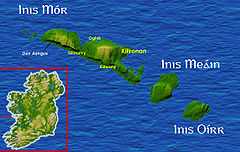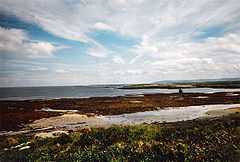Inishmore




Inishmore (Irish: Árainn Mhór or Inis Mór) is the largest of the Aran Islands in Galway Bay in Ireland and has an area of 31 square kilometres (12 sq mi). Inishmore has a population of about 840, making it the largest of the Aran Islands in terms of population. The island is famous for its strong Irish culture, loyalty to the Irish language, and a wealth of Pre-Christian and Christian ancient sites including Dún Aengus, described as "the most magnificent barbaric monument in Europe" by George Petrie.[1]
Name
Prior to the 20th century, the island was more commonly called Inis Bant, or as Árainn na Naomh (Irish: Árainn Mhór) (i.e. "Great Aran") in English; from the traditional Irish name, leading to confusion with Arranmore, County Donegal. The Irish word Árainn means "long ridge" which is an apt description for the island. The name lenited, so the expected name would be Inis Mhór. Árainn is still the official Irish name.
Geology and Geography
The island is an extension of The Burren. The terrain of the island is composed of limestone pavements with crisscrossing cracks known as "grikes", leaving isolated rocks called "clints". The limestones date from the Visean period (Lower Carboniferous), formed as sediments in a tropical sea approximately 350 million years ago, and compressed into horizontal strata with fossil corals, crinoids, sea urchins and ammonites. Glaciation following the Namurian phase facilitated greater denudation. The result is that Inishmore and the other islands are among the finest examples of Glacio-Karst landscape in the world. The effects of the last glacial period (the Midlandian) are most in evidence, with the island overrun by ice during this glaciation. The impact of earlier Karstification (solutional erosion) has been eliminated by the last glacial period. So any Karstification now seen dates from approximately 10,000 years ago and the island Karst is thus recent.
Solutional processes have widened and deepened the grikes of the limestone pavement. Pre-existing lines of weakness in the rock (vertical joints) contribute to the formation of extensive fissures separated by clints (flat pavement like slabs). The rock karstification facilitates the formation of sub-terrainean drainage.
Climate and agriculture
The island has an unusually temperate climate. Average air temperatures range from 15°C in July to 6°C in January. The soil temperature does not usually drop below 6°C, although the end of 2010 recorded a prolonged period of snow, the first in living memory. Since grass will grow once the temperature rises above 6°C, this means that the island (like the neighbouring Burren) has one of the longest growing seasons in Ireland or Britain, and supports a diverse and rich plant life. Late May is the sunniest time,[2] and also likely the best time to view flowers, with the gentians and avens peaking but orchid species blooming late.
The island is located off the west coast of Ireland near Galway. A ferry transports people over to the island, this journey taking roughly 45 minutes. A barge delivers goods to the island every day into the new pier at Kilronan.
Flora and fauna
The island supports arctic, Mediterranean and alpine plants side by side, due to the unusual environment. Like the Burren, the Aran islands are renowned for their remarkable assemblage of plants and animals.[3] The grikes (crevices) provide moist shelter, thus supporting a wide range of plants including dwarf shrubs. Where the surface of the pavement is shattered into gravel, many of the hardier Arctic or Alpine plants can be found. But when the limestone pavement is covered by a thin layer of soil, patches of grass are seen, interspersed with plants like the gentian and orchids. Notable insects present include the butterfly the Pearl-bordered Fritillary Boloria euphrosyne, Brown Hairstreak Thecla betulae, Marsh Fritillary Euphydryas aurinia and Wood White Leptidea sinapis; the moths, the Burren Green Calamia tridens, Irish Annulet Odontognophos dumetata and Transparent Burnet Zygaena purpuralis; and the hoverfly Doros profuges with sightings of the Bantasauras Rex on the island.
Tourism
Inis Mór is a major tourist destination, with bed and breakfast accommodation scattered across the island. Private minibuses, horse-drawn carriages and bicycles are the main methods of getting about for the numerous tourists who visit the island in the summer months, the majority of which are the Irish themselves but with an extraordinary number of British, French and German holiday-makers. There is a small museum illustrating the history of Dún Aenghusa and its possible functions, while The Aran Sweater Market is also a focal point for visitors who can trace the culture and history associated with the Aran sweater through the on-site museum. Nearby are a Neolithic tomb and a small heritage park at Dún Eochla, featuring examples of a traditional thatched cottage and an illegal poteen distillery.[4]
Sport
Some of the limestone sea cliffs have attracted interest from rock-climbers.[5] Diving is possible.[6] From 2012 Inishmore is hosting an event as part of the Red Bull Cliff Diving World Series.
Transport
The island is serviced by Aran Ferries ferry from Rossaveal and Doolin and by Aer Arann Islands from Inishmore Aerodrome to Connemara Airport.
In popular culture
The island features heavily in Martin McDonagh's play The Lieutenant of Inishmore. It was also featured in the 1997 film "The Matchmaker"
Notable inhabitants
- Saint Fanchea, abbess of Killeaney, fl. 500.
- Enda of Aran, early Christian missionary, died c. 530.
- James Concannon, (born 17 March 1847-after 1883), Irish Vintner.
- Maura Derrane, RTE television presenter, born 1970.
- Bridget Dirrane, Centenerian.
- Máirtín Ó Direáin, Irish language poet, 1910–1988.
- Liam O'Flaherty, novelist and short story writer, 28 August 1896 – 7 September 1984.
- Mahon mac Turlough Mantach Ó Briain, Chief of Inishmore, died 1565.
- Murrough mac Toirdelbach Ó Briain, Chief of Inishmore, fl. 1575–1588.
- Pat Mullen, actor and writer, bef.1901- a.1976.
- Breandán Ó hEithir, writer and broadcaster, 1930–1990.
- Tim Robinson (cartographer), author, born 1935.
- Conchobar Mac Con Rí, reputed Supercentenarian, died 1580.
- Murrough na dTuadh Ó Flaithbheartaigh, Chief of Iar Connacht, fl. 1569–1593.
- Ceannanach, early Irish missionary, fl. c. 490–500?
Aran in the Irish annals
Annals of Inisfallen (AI)
- 530 – Enda of Aran, died.
- 654 - St Nem Moccu Birn, successor of Enne, of Ara, died on the 14th of June.
- 751 – Repose of Colmán mac Comán, in Ára.
- 755 – Gaimdibhla, Abbot of Aran, died.
- 916 – Egnech, successor of Enda of Ara, bishop and anchorite, died.
- 1110 – Flann Ua Aedha, successor of Énna of Ára, died.
- 1114 – Maelcoluim Ua Cormacain, successor of Ende of Ara, died.
- AI1015.8 The foreigners of the Isles, viz. with the complement of seven ships, raided the Islands, and they plundered Ara, Inse Mod, and Inis Aingin(?), and carried off one hundred and fifty [captives] as booty.
- AI1016.6 The slaughter of Ára, in which Ua Lochlainn, royal heir of Corcu Modruad, was killed in Port Ciaráin in Ára. It was the Conmaicne who slew him.
- AI1019.4 A great pestilence, i.e. a colic, in Ára in the above year, and many people died there.
- 1167 - Gillagori Ua Dubhacan successor of Einde of Ara, died.
Towns and Villages
- Kilronan
- Kilmurvy
- Killeany
- Oghill
Manister
Annalistic references
AI=Annals of Inisfallen. (AF)M=Annals of the Four Masters.
- AI1016.6 The slaughter of Ára, in which Ua Lochlainn, royal heir of Corcu Modruad, was killed in Port Ciaráin in Ára. It was the Conmaicne who slew him. Death of Muiredach son of Cadla, king of Conmaicne Mara.
- AI1019.4 A great pestilence, i.e. a colic, in Ára in the above year, and many people died there.
- M1186. Conchubhar Ua Flaithbertaigh was killed by Ruaidhri Ua Flaithbertaigh, by his own brother, in Ara.
- M1560.8. Mahon, the son of Turlough, son of Teige, son of Donough, son of Donnell, son of Turlough Meith O'Brien, went into Desmond with the crew of a ship and boat, from the island of Aran. He took prisoners in the southern country, but some assert that the taking of them was of no advantage, and that they only accompanied him through friendship. On his return with his spoils, the wind became rough, and the sky angry; and the ship and boat were separated from each other; and when the ship was making for Aran in the beginning of the night, the sail was swept away from the hands of the men and warriors, and torn to rags off the ropes and tackles, and wafted into the regions of the firmament; and the ship afterwards struck upon a rock, which is at the mouth of Cuan-an-fhir-mhoir, in West Connaught, where she was lost, with her crew, except Mahon and three others. Upwards of one hundred were drowned in that harbour, among whom was Tuathal O'Malley, the best pilot of a fleet of long ships in his time.
- M1565.3. Mahon, the son of Turlough Mantagh, son of Donough, son of Donnell, son of Turlough Meith, was treacherously slain in his own town of Aircin, in Aran, by his own associates and relations. When the chief men of Galway heard of this, they set out to revenge this misdeed upon the treacherous perpetrators, so that they compelled them to fly from their houses; and they the fugitives went into a boat, and put to sea; and where they landed was in the harbour of Ross, in West Corca-Bhaiscinn. Donnell, the son of Conor O'Brien, having heard of this, he hastened to meet them with all the speed that he could exert; and he made prisoners of the greater number of them, and carried them in close fetters to Magh Glae, in the upper part of Corcomroe, in order that their sorrow and anguish might be the greater for being in viev of the place where they had perpetrated the crime; he hanged some of them, and burned others, according as their evil practices deserved.
See also
- List of abbeys and priories in County Galway
| Wikimedia Commons has media related to Inishmore. |
References
- ↑ "The Best of Ancient Ireland". Frommer's. Retrieved 1 March 2009.
- ↑ http://www.met.ie
- ↑ [http://www.jstor.org/pss/20494847, D.A. Webb, 'Noteworthy Plants of the Burren', 1961, Proceedings of the Royal Irish Academy. Section B: Biological, Geological, and Chemical Science]
- ↑ Mario De Carli. "Prehistoric Forts". Retrieved 1 March 2009.
- ↑ http://wiki.climbing.ie/index.php/Aran_Islands
- ↑ http://www.tempoweb.com/diveireland/arans.htm
Coordinates: 53°07′25″N 9°43′39″W / 53.12361°N 9.72750°W